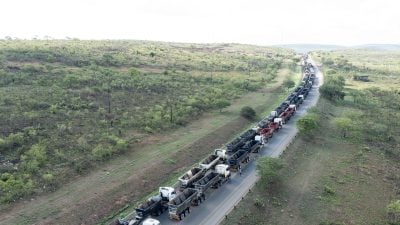In its latest annual report the United Nations’ International Fund for Agricultural Development (IFAD) outlines the steps the organisation has taken to promote food security and rural development in Africa and around the world. In 2022 the body invested $7.96bn in rural areas globally.
“2022 was a particularly challenging year for rural people the world over,” notes IFAD president Alvaro Lario in the foreword.
“Rural communities have acutely felt the effects of this triple crisis [conflict, climate change, and the aftermath of the Covid-19 pandemic] on their food systems, which are a critical source of livelihoods – as well as essential nourishment – for them, and for the millions of people who depend on them.
The role of agrifinance
To help improve the resilience of Africa’s rural economies, IFAD and other international development bodies have explored the potential of “agrifinance”. This refers to financial solutions which allow vulnerable or smallholder farmers, who are often unable to access financial services, to reduce risk and increase the amount of investment they can secure for their farms.
The idea is that, by offering farmers in underserved communities the ability to hedge risk and structure capital investments in a more sophisticated manner, they can increase both their incomes and crop yields. The result is stronger food security for the wider community.
In a November 2021 report on agrifinance IFAD noted that farmers and small-scale entrepreneurs in rural areas are constrained by a “lack of seed capital, poor financial literacy, sector-specific needs, lack of collateral, exclusion from the banking system, lack of access to product market, and long distance to financial service providers”. Agrifinance solutions seek to solve one or more of these challenges and therefore strengthen the resilience of agricultural supply chains.
Read more about agriculture in Africa
- Can AI address Africa’s agricultural trade deficit?
- ‘Africa must substitute food imports by producing locally’
- Africa’s lack of food processing capacity is a missed economic opportunity
Magoba Jerome, CEO at Ndugu Capital, a boutique corporate finance firm based in Kampala, tells African Business that agrifinance is becoming of increased importance because of how heavily many African countries rely on agricultural exports. “Uganda, the Democratic Republic of Congo, pretty much every country in Africa has agricultural products as one of its major exports.
“When it comes to agriculture, most African countries are highly involved in the sector, but the majority of people of course are doing it on a small scale and domestically.”
African companies struggle to compete
The fact that Africa’s agricultural sector largely consists of individual farmers or very small organisations means the space has not been fully commercialised. Producers lack the best quality seeds and fertilisers, while a lack of irrigation infrastructure makes harvests less efficient and more vulnerable to climatic changes, pests and diseases.
Jerome suggests that these factors mean African agricultural companies often struggle to compete with larger players on international markets. He says that coffee exporters in Uganda, Ethiopia, and Tanzania in particular have long been looking for “good avenues for financing and refinancing” to raise the cash that would help them invest in technology and stand them in better stead in a competitive global scene, but their options are often highly limited.
It is certainly true that agrifinance products and services have, to an extent, helped fill the gaps left by legacy finance. In May, the Microfinance Support Center (MSC) in Uganda announced a new scheme to offer smallholder farmers loans at lower interest rates compared to commercial banks. Ugandan banks are currently charging an average of between 20-25% for loans but MSC is to provide farmers cash at just 8%, drastically reducing the cost of investing in technology or product development.
In 2021, Africa saw a 7.5-fold increase in investment in agrifinance solutions, with the amount of cash invested reaching $75m. However, Africa received only a little over 1% of the global total of $600bn, with the international agrifinance market dominated by North American and Indian companies.
Small players miss out
While this growth is to be welcomed, there are concerns that agrifinance-related capital is largely flowing to the continent’s bigger players, rather than smallholder or vulnerable farmers. Indeed, even in the record financing year of 2021, two-thirds of the cash went to one company alone, with Twiga Foods in Nairobi raising $50m in a Series C funding round.
A further $14m went to SunCulture, a solar irrigation firm also based in Nairobi, in a Series A funding round. The amount of cash left for smaller enterprises or individual farmers after these two major deals is therefore highly limited.
“Investors want to put their money in companies that are already doing well,” Jerome tells African Business. “Despite the growth of agrifinance, there are still many challenges when it comes to raising cash for companies which are great but still face financing issues.
“When funds come to the continent from Europe for example, they have been established in order to invest in agriculture in Africa. First of all, our countries are looked at as risky countries for investing in terms of agriculture.
“Let’s say the European Investment Bank is investing in a fund, because usually they don’t invest directly. This fund has to get money from, say, the European Union. The people at the fund will have to do swathes of due diligence and financial modelling. Finding a company in remote parts of rural Africa that meets this type of criteria is very difficult.”
It seems that many small-scale African agriculture companies are trapped in a contradictory position: their limited credit histories and relatively high-risk business models mean they struggle to obtain investment for agrifinance solutions, even though it is exactly these solutions which would help overcome such challenges.
Empowering rural communities
The World Bank has emphasised the critical importance of developing agrifinance and bringing its benefits to more farmers around the world.
“Estimates suggest that the global food demand will increase by 70% by 2050 and at least $80bn annual investments throughout the value chains will be required in response,” the Bank says.
“Smaller investments are needed for farmers and agriculture micro, small and medium enterprises to increase their productivity while reducing environment impact and taking into account climate risks.”
The World Bank also notes that “financial systems in most developing countries are ill prepared to finance the shift to sustainable agriculture and agri-food industries” because “banks, microfinance institutions, and institutional investors have traditionally been providing very limited resources for the sectors.”
It is clear that agrifinance solutions have an important role to play in empowering rural communities, strengthening supply chains in Africa and beyond, as well as facilitating a broader shift to more sustainable agricultural practices. However, Jerome says the full potential of the sector will not be unleashed until it achieves much broader coverage and brings in the full scope of agricultural enterprises, large and small.
“As African countries, I think this is the question we should be looking at: how to ensure all micro or small agricultural companies benefit from the potential of agrifinance?”
Want to continue reading? Subscribe today.
You've read all your free articles for this month! Subscribe now to enjoy full access to our content.
Digital Monthly
£8.00 / month
Receive full unlimited access to our articles, opinions, podcasts and more.
Digital Yearly
£70.00 / year
Our best value offer - save £26 and gain access to all of our digital content for an entire year!

 Sign in with Google
Sign in with Google 



